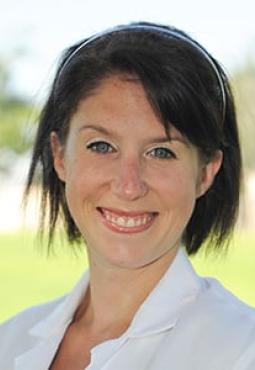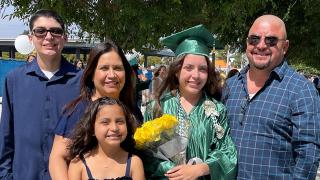Sebastian "Diego" Serna is a happy, healthy 16-year-old with big plans.
“I want to finish high school,” he says, “then go to college, study criminal justice and go into law enforcement. Maybe the FBI, the CIA or a SWAT team.”
Dad is on board.
“I’ve always encouraged my kids to reach for the stars, and that would be perfect,” said Isaias Serna.
The elder Serna also encouraged a love of music and Mexican traditions. A construction worker by day, Isaias teaches mariachi to youngsters, and Diego frequently plays trumpet in Dad’s traveling youth troupes.
When you meet Diego, you would never suspect that this soft-spoken, smiling teen with glasses and a mop top had ever fought a deadly disease. But barely three years earlier, it was far from certain that Diego would reach his 16th birthday.
The first sign of trouble appeared in November 2020. Father and son were working on a building project in the backyard of their Gardena, California home. Unexpectedly, Diego felt weak, unable to lift anything.
More symptoms followed: headaches, fever, nausea, diarrhea. “I was really sick for a month,” recalled Diego. His urgent care doctors blamed COVID. But by January, a very un-COVID-like affliction took hold: severe pain in Diego’s hands. “They hurt and they were swollen,” he remembered. Alarmed, his parents rushed Diego to the emergency room.
“Within 30 minutes of doing the bloodwork,” said Isaias, “they knew something was wrong. After an hour and a half, they told us. It was cancer.”
Completely Unexpected
Diego was diagnosed with acute lymphoblastic leukemia, the most common of all childhood cancers. ALL starts in the bone marrow but can spread to other areas including the central nervous system.
Diego couldn’t process the news right away. He was “out of it” from the morphine pumped into his system to alleviate his hand pain. His parents, however, did react. Mom cried hysterically. Dad felt helpless.
'She’s the first doctor I had met who told me the whole truth.'
Isaias Serna, father of patient Diego, of Nicole Karras, M.D.
“I was scared,” said Isaias, his voice cracking. “I didn’t know what to do. I lost control. Everything had been perfect before. He was never hurt. Not a broken bone. This was devastating. As a father, you think you have some control. But this was something I couldn’t fix.”
Fortunately, childhood leukemia is considered highly curable, with a better than 90% survival rate. This is what local oncologists told the Sernas, as they mapped out a treatment plan for Diego: up to three years of chemotherapy, beginning with aggressive drugs, then tapering to lower-dose, “maintenance” medication. It was encouraging news.
Not Responding to Treatment
The optimism didn’t last. Almost from the start of treatment, Diego suffered new and crippling symptoms. Aside from the fatigue, hair loss, nausea and loss of appetite typically associated with chemo, Diego developed pancreatitis. He was also stricken with a serious infection on his arm and developed facial paralysis.
Switching chemo drugs helped a little, but the big blow came a year into Diego’s treatment when, after some progress, his leukemia relapsed and doctors deemed it necessary to start over again.
“I cried a lot,” Diego said. “I felt really sad. I’d had a lot of hope, and this brought it all down.”
Isaias had quit his job to be at Diego’s bedside every day. The need to return to square one was almost too much to bear. “The doctors had told us the hard part was over. I thought we’d climbed that peak. This was very tough.”

Worse, even after starting over, it became apparent that Diego was not responding. His only remaining hope would be a stem cell transplant. That’s when his local doctors reached out to City of Hope, where more than 18,000 such transplants have been performed.
“Diego came to us because his leukemia had relapsed and spread into his central nervous system,” recalled Nicole A. Karras, M.D., pediatric hematologist-oncologist and associate clinical professor in the Department of Pediatrics, City of Hope Children's Cancer Center. “He couldn’t move his face muscles, something especially distressing for a teen” — especially a teen trumpet player.
Karras was impressed by the Sernas.
“They’re a lovely family, and so supportive of Diego,” she said. “They’d been through a lot.”
Looking at Diego’s treatment history, Karras realized that some of his chemotherapy drugs may have triggered allergic reactions. How then, to prep for a transplant? Normally chemotherapy comes first, to destroy the existing bone marrow so that a healthy new blood system can be built using donor stem cells. Diego’s case would require some out-of-the-box thinking.
A Powerful Immunotherapy
Ultimately, Karras turned to a powerful weapon that has been changing cancer care over the last several years.
CAR T cells.
For nearly a decade, City of Hope has pioneered chimeric antigen receptor (CAR) T cell therapy, which uses a patient’s own immune system to fight cancer. There are now several FDA-approved CAR T cell treatments, including one tailor-made for children with ALL.
“Diego still had some cancer in his marrow,” said Karras, “so we opted for CAR T cell therapy to reduce his tumor load before transplant” instead of chemotherapy.
The Sernas had never heard of CAR T cells, but listening to Karras, they knew they had come to the right place.
“She’s the first doctor I had met who told me the whole truth,” Isaias said. He remembered how Karras was straightforward and didn’t sugarcoat. “She said a transplant could heal him. Or he could die. I liked that about her. I realized I was finally hearing from someone who was sure of what she was doing.”
Isaias also appreciated everything City of Hope would ultimately do to make Diego’s long hospital stays more tolerable.
“They paid some of our utility bills,” he said, “They paid for gas, groceries, they gave us a bunch of gift cards. At Christmas, they sent this huge tree covered with gift cards!”
Diego got special attention from Davis Wideman, adolescent and young adult (AYA) activities coordinator, and child life specialist Marisol Trujillo, M.S., CCLS.
“Marisol was always checking up on me, playing board games with me,” recalled Diego. “Davis and I played video games, and he’d take me to the game room” to socialize with other patients.
Standard stuff, says Trujillo.
“It is important to treat them like a person and not just a patient,” she said. “Doing things that they enjoy helps normalize the environment and helps them cope.”
Exactly, echoed Wideman, who got Diego involved in pet therapy, arts and crafts, painting classes and more. “It’s important for someone Diego’s age to have engaging activities and conversations to keep him busy and give him that sense of normalcy,” he said.
A Quick Turnaround
Karras says Diego handled the CAR T procedure “quite well” and began to feel better quickly. Although in some cases successful CAR T treatment makes a transplant unnecessary, Karras felt that Diego’s cancer cells were too aggressive to take that chance. They would go forward with a transplant once a donor was found.
They didn’t have to search far. Both of Diego’s sisters were a 50% match. Karras chose the elder, Sophia, who was closest in size to Diego and had the same blood type.
The actual transplant is relatively simple — resembling an IV transfusion — but prepping for it can be challenging. In addition to readying the CAR T treatment — which can take weeks — Diego also underwent total body radiation plus extra cranial radiation — part of the standard conditioning regimen in transplant cases.
Diego’s transplant took place at the end of January 2022. A few days afterward, he ran a fever due to a mild case of graft versus host disease (GVHD). The radiation also left some rashes that required painkillers. But by the fourth week, Diego felt so good he thought, “I shouldn’t be here anymore. I wanted to get out!”
Tooting His Horn — And Ours
A year and a half later, Diego is cancer-free. He no longer takes any immunosuppressant drugs for the GVHD. The facial paralysis is gone. He’s back in school — and he’s blowing the trumpet!
Music to his doctor’s ears.
“My goal each time is that after one year, nobody knows you even had a transplant,” said Karras. She’ll monitor Diego over the next two years, when risk of recurrence is highest. She is rejoicing in this success. “This is the reason I do this.”
Diego’s journey has turned the Serna family into believers.
“I tell everyone I meet,” said Isaias, “that City of Hope is a totally different place. Everybody there totally knows what they’re doing. Everyone really cares about the patients. I saw how they took care of my son.
“If you’re diagnosed with cancer, go to City of Hope.”
Main photo: The Serna family, left to right: Diego, mom Maria, sisters Camila and Sophia, and dad Isaias.
At City of Hope Children’s Cancer Center, our pediatric team is dedicated to delivering world-class, personalized care for children, adolescents and young adults. Each patient is cared for by a multidisciplinary team of oncologists, hematologists, surgeons, radiation therapists, pathologists and supportive care staff. Our specialists have access to leading-edge treatments, including our world-renowned stem cell and bone marrow transplantation programs and the latest clinical trials. Our care teams work together to develop a unique, targeted treatment plan for every patient while providing family support.
